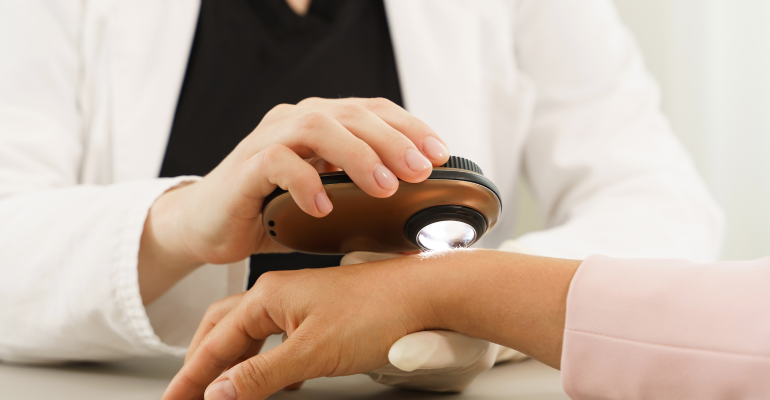Skin cancer is the uncontrolled, abnormal growth and multiplication of cells and is often caused by extensive or prolonged exposure to the sun's harmful ultraviolet (UV) rays. Nearly one in five people develop skin cancer sometime in their life, and it can affect people of all skin tones. The good news is that nearly all skin cancers can be cured if diagnosed and treated early.
According to a 2019 report by the UAE National Cancer Registry, skin cancer is the fourth most common cancer in the UAE after breast, thyroid, and colorectal cancers. It is the second leading cause of cancer among men and sixth among women.
The three main types of skin cancer are basal cell carcinoma, squamous cell carcinoma, and melanoma. While basal cell and squamous cell carcinomas are the most common and usually not life-threatening, melanoma is a more aggressive form of skin cancer that can spread to other organs and is difficult to treat if it is not caught early.
Cleveland Clinic Abu Dhabi’s oncology and dermatology teams share more details on the types of skin cancer and ways to prevent them.
Dr. Ahmed Aldhaheri, Staff Physician in the Medical Subspecialty Institute
Dr. Ahmed Aldhaheri, Staff Physician in the Medical Subspecialty Institute, says, “While there are various treatment options available for skin cancer, it is important to focus on prevention, as it is always better than treatment. The first line of defence to prevent skin cancer is to protect your skin from the sun’s harmful UV rays. This can be done by wearing protective clothing such as long-sleeved shirts, long pants, and wide-brimmed hats, as well as sunglasses that are UV-protected. Additionally, applying sunscreen with an SPF of at least 30 and wearing lip balm, even on cloudy days, should be a part of your daily routine. Sunscreen should be applied generously and reapplied every two hours or after swimming or exercising in the sun, as you are prone to sweat.”
Avoiding the sun during peak hours (between 10 am and 4 pm), as the sun's rays are strongest during this time, is also advisable. Seeking shade and using a beach umbrella or other sunshade can also help protect you from direct sunlight.

Dr. Fatima Al Faresi, Staff Physician in the Medical Subspecialties Institute
“Tanning beds have become a growing fad across the world as people seek that ‘sun-kissed glow’. However, these should be avoided, as they emit harmful UV radiation. They are especially dangerous for young people, as they can increase their risk of developing skin cancer later in life,” Dr. Fatima Al Faresi, Staff Physician in the Medical Subspecialties Institute, continues, “While prevention is the best approach, it is also important to detect skin cancer early so that it can be treated effectively. Everyone should examine their skin regularly for any signs of skin abnormality or changes which can help detect the disease early when it is most treatable. This includes checking moles and other skin lesions for any changes in size, shape, or colour.”

Dr. Raghda Al Maashari, Staff Physician, Dermatology, Medical Subspecialties Institute
Dr. Raghda Al Maashari, Staff Physician, Dermatology, Medical Subspecialties Institute, says, “We usually recommend following the ABCDE rule, which helps identify abnormalities and red flags related to skin cancer.” The ABCDE rule alerts you to signs to watch for:
- Asymmetry: Irregular shape
- Border: Blurry or irregularly shaped edges
- Colour: Mole with more than one colour
- Diameter: Larger than a pencil eraser (6 mm)
- Evolution: Enlarging, changing in shape, colour, or size (this is the most important sign)
“Your skin is the largest organ in your body and needs as much attention as any other health concern. What may seem like an innocent cosmetic imperfection may not be. Therefore, performing regular skin self-checks is important for everyone, especially if you fall in the high-risk zone.”
Cleveland Clinic Abu Dhabi’s skin cancer programme consults patients with various oncology needs. Annual skin examination is recommended for anyone who has had:
- Previous melanoma, skin cancer, or precancerous lesions.
- A first-degree relative (parent, sibling or child) with melanoma.
- Numerous or unusual moles.
- History of tanning bed use.
- History of blistering sunburns.
- Regular sun exposure.
- An organ transplantation.
Also, keep in mind that having a family history of the disease can increase your risk of developing it.

Dr. Ahmad Matalkah, Staff Physician and Surgical Oncologist at the Digestive Disease Institute and Oncology Institute concludes, “Your doctor may advise doing a biopsy to identify if the lesion is malignant and, if so, what kind of skin cancer it is. A biopsy identifies the exact type of cancer and its staging, that is, how far the cancer has progressed. This information, alongside other factors such as the age of the patient and overall health, allows us to determine the best treatment plan.”
But foremost, taking proactive steps to protect your skin can ensure a healthier future and a reduced risk of skin cancer.
Back to Clinical
